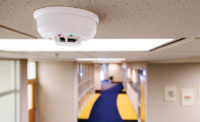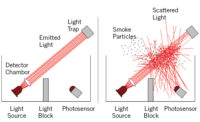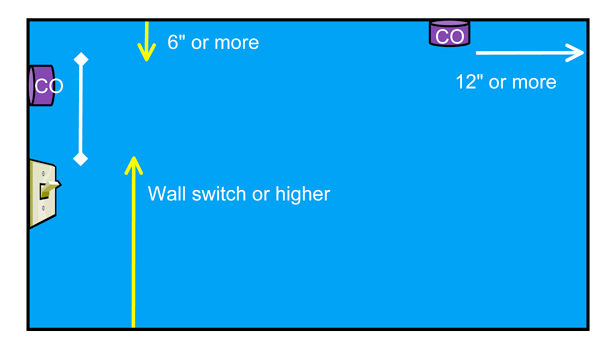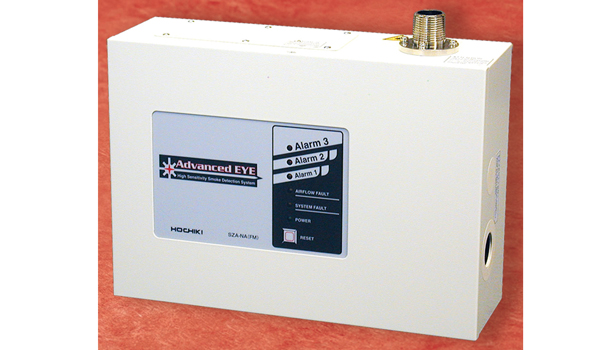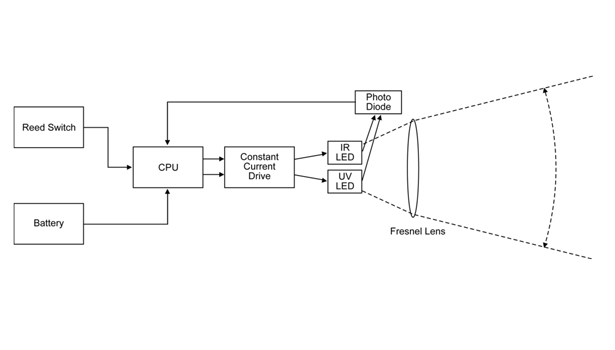Commercial CO Detection Requirements on the Rise
Authorities increasingly are mandating carbon monoxide detection for certain commercial buildings, driven by new standard and code requirements.
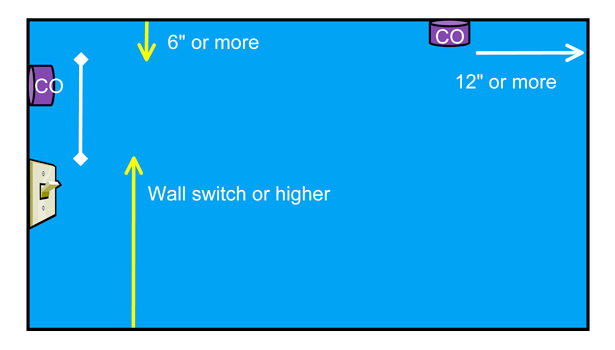
The NFPA 720 standard details how CO detectors should be mounted.
GRAPHIC COURTESY OF NATIONAL TRAINING CENTER

Aspirating smoke detectors use perforated tubing connected to a control box (shown here), providing early smoke detection.
PHOTO COURTESY OF HOCHIKI

Virtually all of the experts interviewed for this article note that there have not been many changes to smoke detector requirements in IBC/ IFC and NFPA codes and standards.
But the 2013 version of the NFPA 72 National Fire Alarm & Signaling Code, expected to be finalized in June, does contain a few new elements.
One of these is support for verification of fire alarm signals if the responsible fire department requires such verification as a means of reducing false alarms, notes Richard Roberts of Honeywell Life Safety. Roberts adds, however, that the verification process is not allowed to take longer than 90 seconds. As Lee Richardson, staff liaison for the NFPA explains, the 2013 version of NFPA 72 also aims to simplify testing and inspection forms and to clarify when smoke detectors are required above suspended ceilings.
GRAPHIC COURTESY OF XTRALIS



To date carbon monoxide (CO) detection has been a requirement primarily for residential installations. But that’s changing fast.
Some states have passed laws requiring CO detection in commercial buildings with sleeping areas such as hotels and dormitories, as well as residences. The latest versions of the International Building Code (IBC), International Fire Code (IFC) and several National Fire Protection Association (NFPA) codes and standards have similar requirements.
These new requirements are not in force everywhere yet. It’s up to individual authorities having jurisdiction (AHJ) if and when to adopt these standards, which are updated every few years. For example, the committee in charge of the NFPA 720 Standard for the Installation of Carbon Monoxide Detectors & Warning Equipment approved the 2012 version of the standard last year, but some AHJs have not yet adopted the previous 2009 version.
In this article we look at the requirements of the most recent versions of the IBC, IFC and NFPA standards as they pertain to CO detection for commercial installations — and at how the 2013 version of the NFPA 72 National Fire Alarm & Signaling Code, which is close to finalization, also could impact CO detector requirements. This article is not a substitute for a thorough reading of the actual codes and standards. Any security dealers installing CO detectors should consult the appropriate codes and standards for details.
New Code Requirements
When determining life safety requirements, AHJs traditionally have looked either to the NFPA101 Life Safety Code or the International Building Code — and now that the 2012 versions of both standards include requirements for CO detection in certain commercial applications, we should expect to see more and more jurisdictions basing their CO detector requirements on these standards. As Jeff Brooks, senior product manager for Westminster, Mass.-based manufacturer Tyco Fire Protection Products points out, that should help bring a higher level of consistency to CO detection requirements, which currently vary considerably from state to state.
“Where you typically had individual states developing their own mandates, we now have made gains in more states just because of IBC and IRC adoption,” notes Brooks, who also participates on several related industry committees. (The IRC is the International Residential Code.)
As Richard Roberts, industry affairs manager for Northford, Conn.-based manufacturer Honeywell Life Safety explains, the new NFPA 101 Life Safety Code requires CO detection in newly constructed day care centers, lodging and rooming houses, hotels, dormitories and apartment buildings (as well as one- and two-family dwellings), with certain exceptions. Dealers should consult the actual standards for details, advises Roberts, who is a member of several industry standards committees.
Roberts also maps out the CO detection requirements in the latest versions of the IBC and IFC. These requirements include new and existing “Group R” and “Group I” occupancies such as hotels, dormitories, apartment buildings, hospitals and nursing homes if the building contains a fuel-burning appliance or attached garage, Roberts describes. There are also several other exceptions, such as when the sleeping or dwelling unit is located more than one story above or below any story which contains a fuel-burning appliance or attached garage.
When CO detectors are required, both the NFPA 101 code and the IBC/ IFC codes direct dealers to the NFPA 720 standard for installation requirements. That standard focuses largely on installation requirements designed to protect sleeping areas. But as Roberts notes, CO detection also is required in certain non-sleeping locations in hotels, dormitories and apartment buildings. These locations include the ceiling in rooms containing a permanently installed fuel-burning appliance and a central location within occupiable spaces served by the first supply air register from a fuel-burning HVAC system.
In an article in SDM’s February 2012 issue about CO and smoke detection for residential applications, Roberts outlined several key differences between the 2009 and 2012 versions of the NFPA 720 standard involving testing and secondary power supply requirements. These differences also apply to CO detection for commercial accounts. (For details see http://www.sdmmag.com/articles/87464-smoke---co-detector-standards-updated.)
It’s also important to note that the 2012 version of NFPA 720 includes a requirement for a 520 Hz audible alarm tone designed to wake adults with hearing loss and alcohol-impaired people. Dealers are required to provide this capability upon customer request for residential accounts. However, for commercial accounts it will be mandatory beginning on January 1, 2015, Roberts explains.
More Changes Ahead
The 2013 version of the NFPA 72 National Fire Alarm & Signaling Code, expected to be finalized at a Technical Meeting at the NFPA Annual Conference in June, is poised to create at least one important additional CO detection requirement. The reason this requirement is contained in the fire standard is that security dealers typically connect CO detectors to fire panels and the new requirements impact the interface between the detector and the panel, Brooks comments.
Until now some dealers have set up CO alarms to report as fire alarms or as trouble signals to the central station, but the new version of the NFPA 72 standard will require CO alarms to have their own unique reporting capabilities, Brooks says.
Brooks also outlines some state-level developments that could impact CO detector requirements. Despite the incorporation of detailed CO requirements in the IBC and NFPA standards, Brooks notes that some states are still looking to create their own unique requirements. And at least two states — Connecticut and Maryland — are considering legislation that would impose a requirement that is not encompassed in the IBC/IFC or NFPA codes and which would require CO detection to be installed in schools.
|
4 CO and Fire Detection Tips |
|
Sources interviewed for this story shared several useful tips about the selection and application of CO and smoke detectors. 1.Consider moving to the forefront. “Most states will allow you to use a newer version of a code even if they haven’t adopted it yet,” advises Tom Hammerberg, president and executive director of the Automatic Fire Alarm Association. Hammerberg cautions, however, that dealers still must obtain approval from the AHJ before they can exercise this option. Dealers also must follow the newer code in its entirety; they can’t cherry pick only their favorite parts, Hammerberg says. 2.Make broader use of CO detectors. CO detectors can do more than just alert inhabitants about unhealthy levels of CO, notes Larry Mann, who is a project manager for Birmingham, Ala.-based dealer Central Station Inc. and also serves on several industry committees. By using the CO detector to trip a relay, it can be used to automatically turn on fans or shut off gas supplies to appliances, Mann notes. 3.Consider aspirating smoke detectors. Aspirating detectors can detect minute particles of combustion by using perforated tubing to collect air samples, potentially providing earlier warning of a fire. These detectors have been around for quite a few years, but recently they’ve become increasingly popular, says Bryan McLane, vice president of sales for Las Vegas-based National Training Center. McLane attributes the increased interest, in part, to increased use of data centers where a fire could be especially catastrophic. Aspirating smoke detectors also have come down in price recently and that is broadening the types of applications where they are used, notes Wayne Oliver, district manager for Buena Park, Calif.-based manufacturer, Hochiki America. These new lower-cost aspirating smoke detectors can be particularly useful for protecting elevator shafts and atriums because they eliminate the need to install and service smoke detectors in difficult-to-reach places. 4.Consider smoke imaging detection for open areas. Shane Clary, vice president of codes and standards compliance for Pacheco, Calif.-based dealer Bay Alarm, says his company is looking at using new technology called Open-Area Smoke Imaging Detection from Norwell, Mass.-based Xtralis. The product uses a camera-like device called an “imager” that receives infrared and ultraviolet light signals from up to seven “emitters” installed around a large protected area. The product is designed to create an alarm when light reception is altered due to the presence of smoke particles. |
| New Product Testing Options |
|
NFPA guidelines require smoke detectors installed in residential or commercial installations to conform to standards established by UL. Assuming the local authority having jurisdiction has adopted NFPA requirements, no product can be used in a residential or commercial installation unless an independent third-party testing laboratory has confirmed that the product meets UL standards. Standards for smoke detectors for commercial applications are described in the UL 268 standard, while the UL 217 standard covers residential smoke detectors, explains Rich Hoffman, life safety team leader for Intertek, an independent third-party testing laboratory with U.S. headquarters in Houston. Intertek has expanded operations in its Arlington Heights, Ill., lab and has a 3 in 1 smoke room that can verify whether a product meets either of these standards, as well as standards required for use in Canada or Europe. “There are different smoke and time profiles and measurement equipment that you need to use,” explains Hoffman. Even though the standards for different countries specify different room sizes, Intertek is able to accommodate all of the requirements in a single testing room. Within a half hour the room can be reconfigured for testing for a different market, the company says. |
Looking for a reprint of this article?
From high-res PDFs to custom plaques, order your copy today!



